Evaluating Telephone-Based Support for Postpartum Depression
VerifiedAdded on 2021/06/17
|12
|2421
|19
Report
AI Summary
This report presents a study investigating the effectiveness of telephone-based support in mitigating postpartum depression among new mothers. The research involved sixty participants, equally divided between high and low socioeconomic statuses and functional families. Participants were assessed using the Latrobe post-natal depression questionnaire, with half of each group receiving a telephone-based counseling program. The study aimed to determine if this support reduced postpartum depression symptoms. The results, analyzed using Microsoft Excel, indicated that telephone-based support significantly reduced postpartum depression, with a lower p-value than the significance level of 0.05. The analysis showed that mothers receiving support experienced fewer depressive symptoms compared to the control group. The report highlights the importance of early screening and support for prenatal and postpartum depression, emphasizing the positive impact of social support and the need for public education on maternal mental health. The findings underscore the potential of telephone-based interventions to improve maternal and infant well-being, irrespective of socioeconomic status.

Running head: POSTPARTUM DEPRESSION 1
Report on postpartum depression
Name
Course
Institution
Date
Report on postpartum depression
Name
Course
Institution
Date
Paraphrase This Document
Need a fresh take? Get an instant paraphrase of this document with our AI Paraphraser
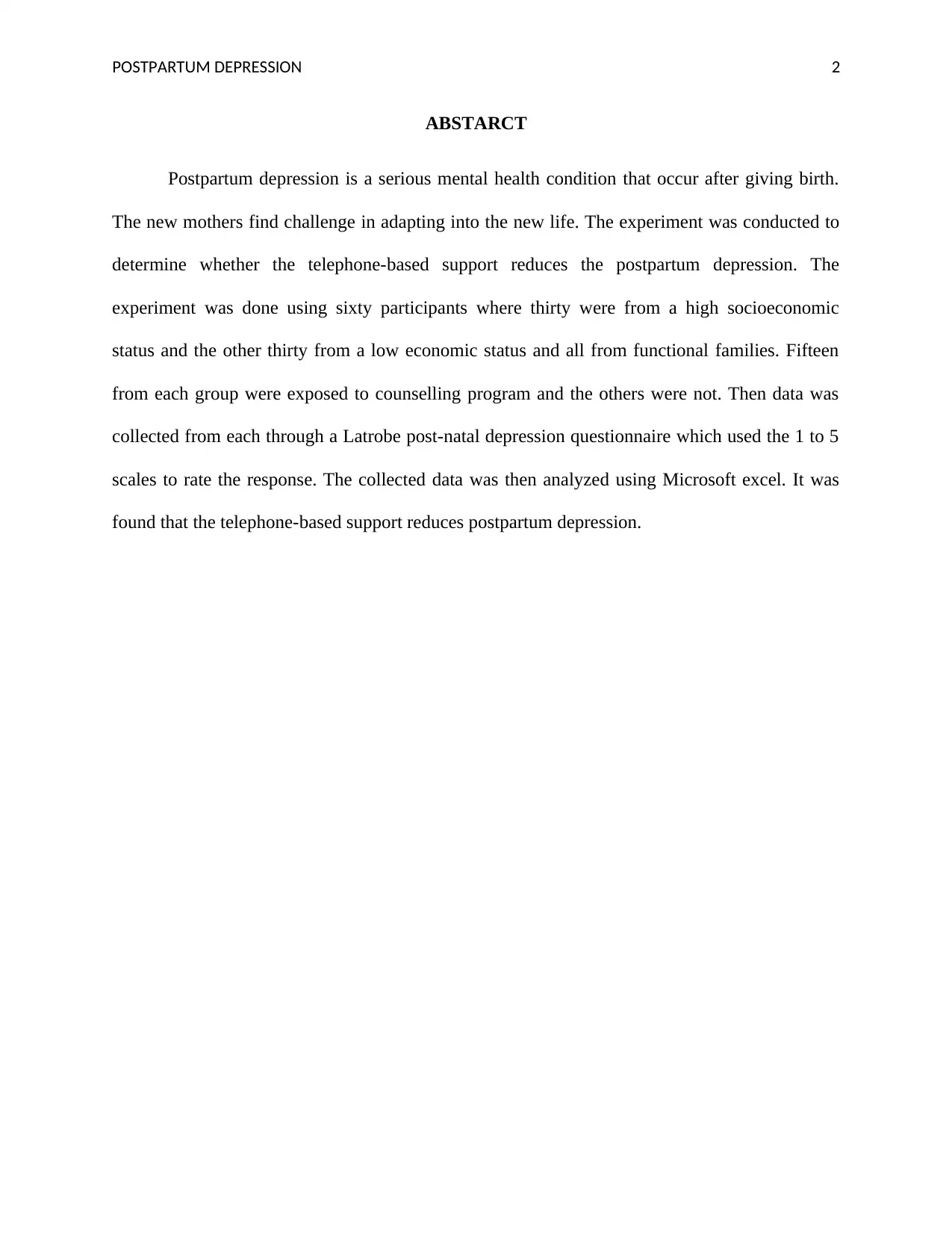
POSTPARTUM DEPRESSION 2
ABSTARCT
Postpartum depression is a serious mental health condition that occur after giving birth.
The new mothers find challenge in adapting into the new life. The experiment was conducted to
determine whether the telephone-based support reduces the postpartum depression. The
experiment was done using sixty participants where thirty were from a high socioeconomic
status and the other thirty from a low economic status and all from functional families. Fifteen
from each group were exposed to counselling program and the others were not. Then data was
collected from each through a Latrobe post-natal depression questionnaire which used the 1 to 5
scales to rate the response. The collected data was then analyzed using Microsoft excel. It was
found that the telephone-based support reduces postpartum depression.
ABSTARCT
Postpartum depression is a serious mental health condition that occur after giving birth.
The new mothers find challenge in adapting into the new life. The experiment was conducted to
determine whether the telephone-based support reduces the postpartum depression. The
experiment was done using sixty participants where thirty were from a high socioeconomic
status and the other thirty from a low economic status and all from functional families. Fifteen
from each group were exposed to counselling program and the others were not. Then data was
collected from each through a Latrobe post-natal depression questionnaire which used the 1 to 5
scales to rate the response. The collected data was then analyzed using Microsoft excel. It was
found that the telephone-based support reduces postpartum depression.
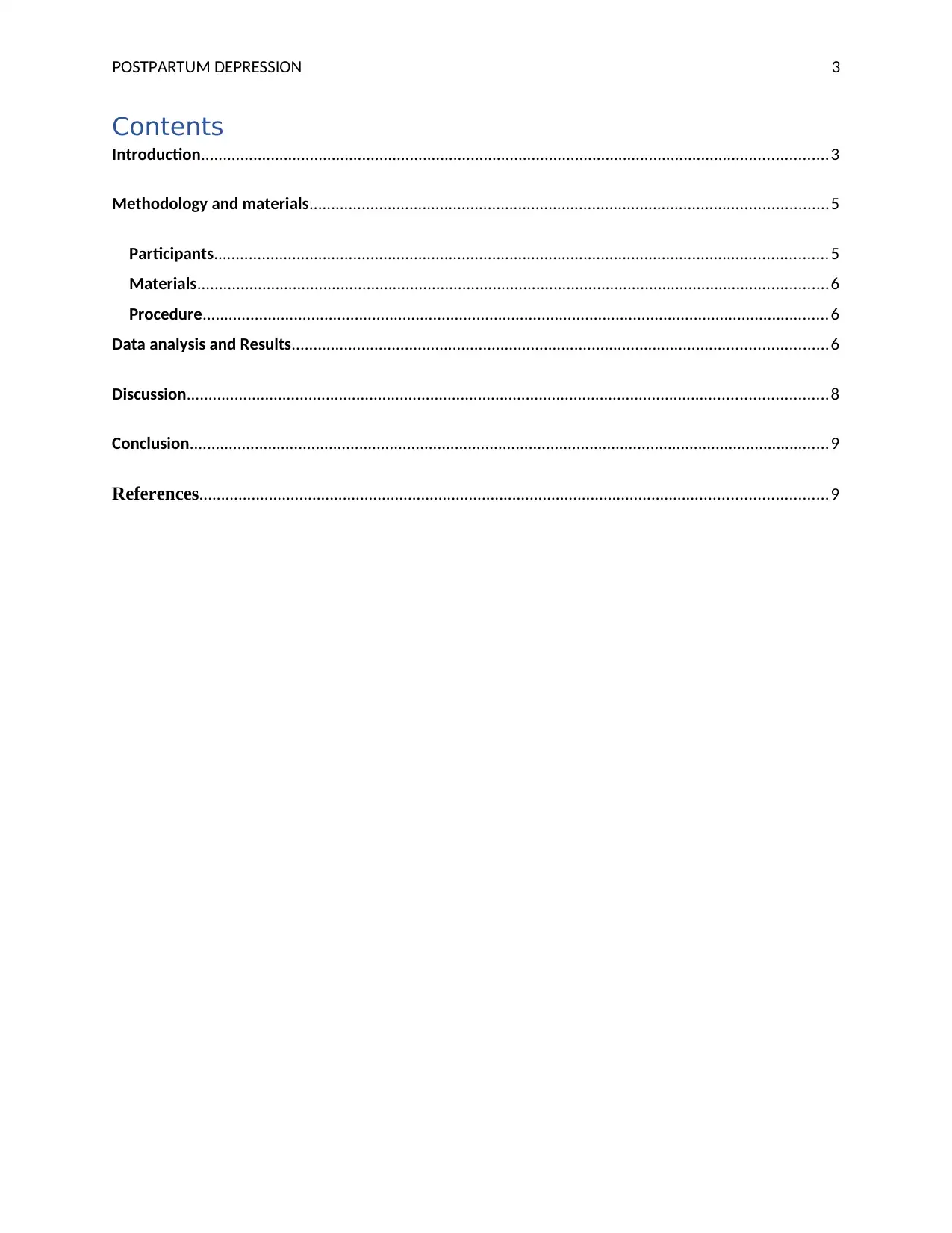
POSTPARTUM DEPRESSION 3
Contents
Introduction................................................................................................................................................3
Methodology and materials.......................................................................................................................5
Participants.............................................................................................................................................5
Materials.................................................................................................................................................6
Procedure................................................................................................................................................6
Data analysis and Results...........................................................................................................................6
Discussion...................................................................................................................................................8
Conclusion...................................................................................................................................................9
References................................................................................................................................................9
Contents
Introduction................................................................................................................................................3
Methodology and materials.......................................................................................................................5
Participants.............................................................................................................................................5
Materials.................................................................................................................................................6
Procedure................................................................................................................................................6
Data analysis and Results...........................................................................................................................6
Discussion...................................................................................................................................................8
Conclusion...................................................................................................................................................9
References................................................................................................................................................9
⊘ This is a preview!⊘
Do you want full access?
Subscribe today to unlock all pages.

Trusted by 1+ million students worldwide
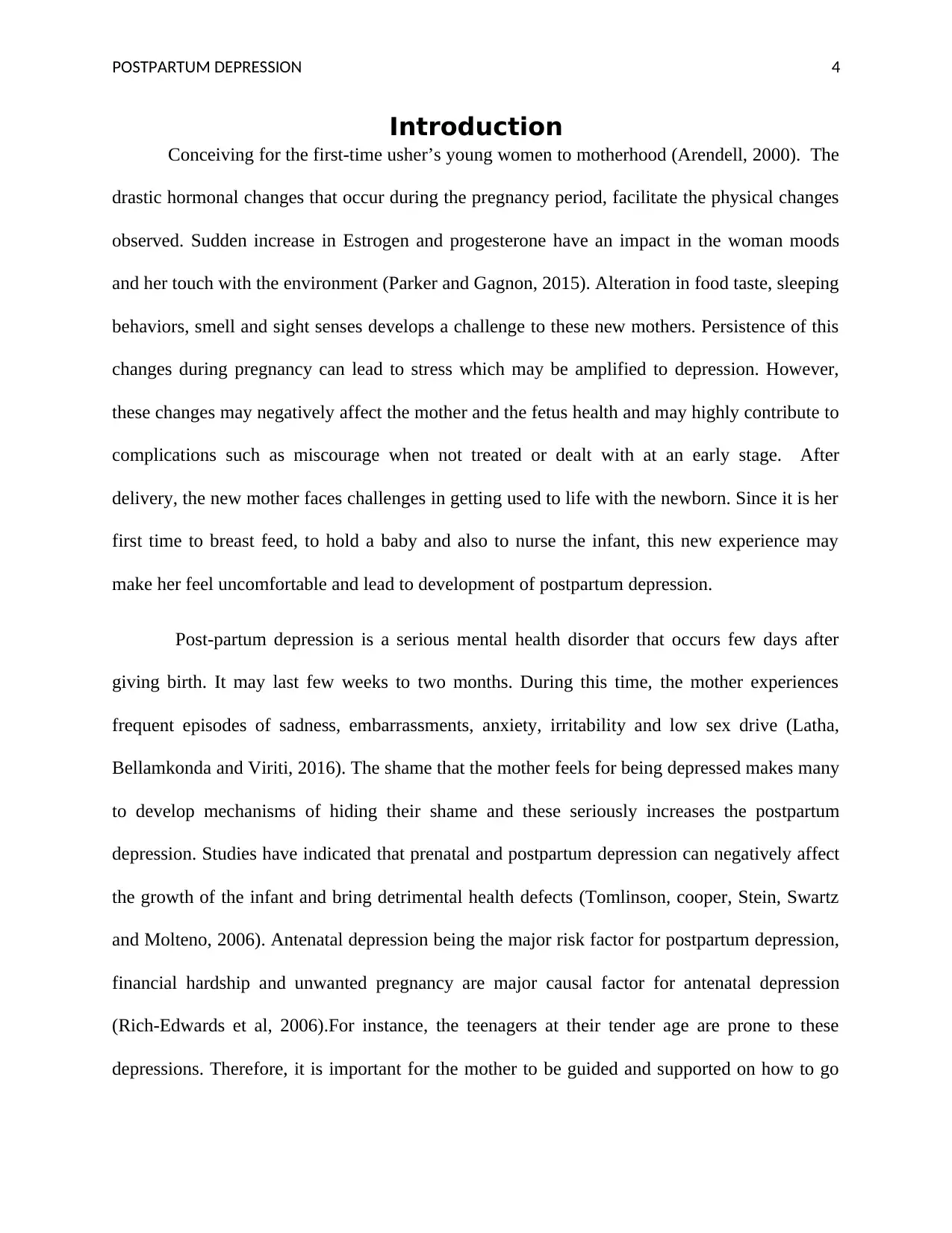
POSTPARTUM DEPRESSION 4
Introduction
Conceiving for the first-time usher’s young women to motherhood (Arendell, 2000). The
drastic hormonal changes that occur during the pregnancy period, facilitate the physical changes
observed. Sudden increase in Estrogen and progesterone have an impact in the woman moods
and her touch with the environment (Parker and Gagnon, 2015). Alteration in food taste, sleeping
behaviors, smell and sight senses develops a challenge to these new mothers. Persistence of this
changes during pregnancy can lead to stress which may be amplified to depression. However,
these changes may negatively affect the mother and the fetus health and may highly contribute to
complications such as miscourage when not treated or dealt with at an early stage. After
delivery, the new mother faces challenges in getting used to life with the newborn. Since it is her
first time to breast feed, to hold a baby and also to nurse the infant, this new experience may
make her feel uncomfortable and lead to development of postpartum depression.
Post-partum depression is a serious mental health disorder that occurs few days after
giving birth. It may last few weeks to two months. During this time, the mother experiences
frequent episodes of sadness, embarrassments, anxiety, irritability and low sex drive (Latha,
Bellamkonda and Viriti, 2016). The shame that the mother feels for being depressed makes many
to develop mechanisms of hiding their shame and these seriously increases the postpartum
depression. Studies have indicated that prenatal and postpartum depression can negatively affect
the growth of the infant and bring detrimental health defects (Tomlinson, cooper, Stein, Swartz
and Molteno, 2006). Antenatal depression being the major risk factor for postpartum depression,
financial hardship and unwanted pregnancy are major causal factor for antenatal depression
(Rich-Edwards et al, 2006).For instance, the teenagers at their tender age are prone to these
depressions. Therefore, it is important for the mother to be guided and supported on how to go
Introduction
Conceiving for the first-time usher’s young women to motherhood (Arendell, 2000). The
drastic hormonal changes that occur during the pregnancy period, facilitate the physical changes
observed. Sudden increase in Estrogen and progesterone have an impact in the woman moods
and her touch with the environment (Parker and Gagnon, 2015). Alteration in food taste, sleeping
behaviors, smell and sight senses develops a challenge to these new mothers. Persistence of this
changes during pregnancy can lead to stress which may be amplified to depression. However,
these changes may negatively affect the mother and the fetus health and may highly contribute to
complications such as miscourage when not treated or dealt with at an early stage. After
delivery, the new mother faces challenges in getting used to life with the newborn. Since it is her
first time to breast feed, to hold a baby and also to nurse the infant, this new experience may
make her feel uncomfortable and lead to development of postpartum depression.
Post-partum depression is a serious mental health disorder that occurs few days after
giving birth. It may last few weeks to two months. During this time, the mother experiences
frequent episodes of sadness, embarrassments, anxiety, irritability and low sex drive (Latha,
Bellamkonda and Viriti, 2016). The shame that the mother feels for being depressed makes many
to develop mechanisms of hiding their shame and these seriously increases the postpartum
depression. Studies have indicated that prenatal and postpartum depression can negatively affect
the growth of the infant and bring detrimental health defects (Tomlinson, cooper, Stein, Swartz
and Molteno, 2006). Antenatal depression being the major risk factor for postpartum depression,
financial hardship and unwanted pregnancy are major causal factor for antenatal depression
(Rich-Edwards et al, 2006).For instance, the teenagers at their tender age are prone to these
depressions. Therefore, it is important for the mother to be guided and supported on how to go
Paraphrase This Document
Need a fresh take? Get an instant paraphrase of this document with our AI Paraphraser
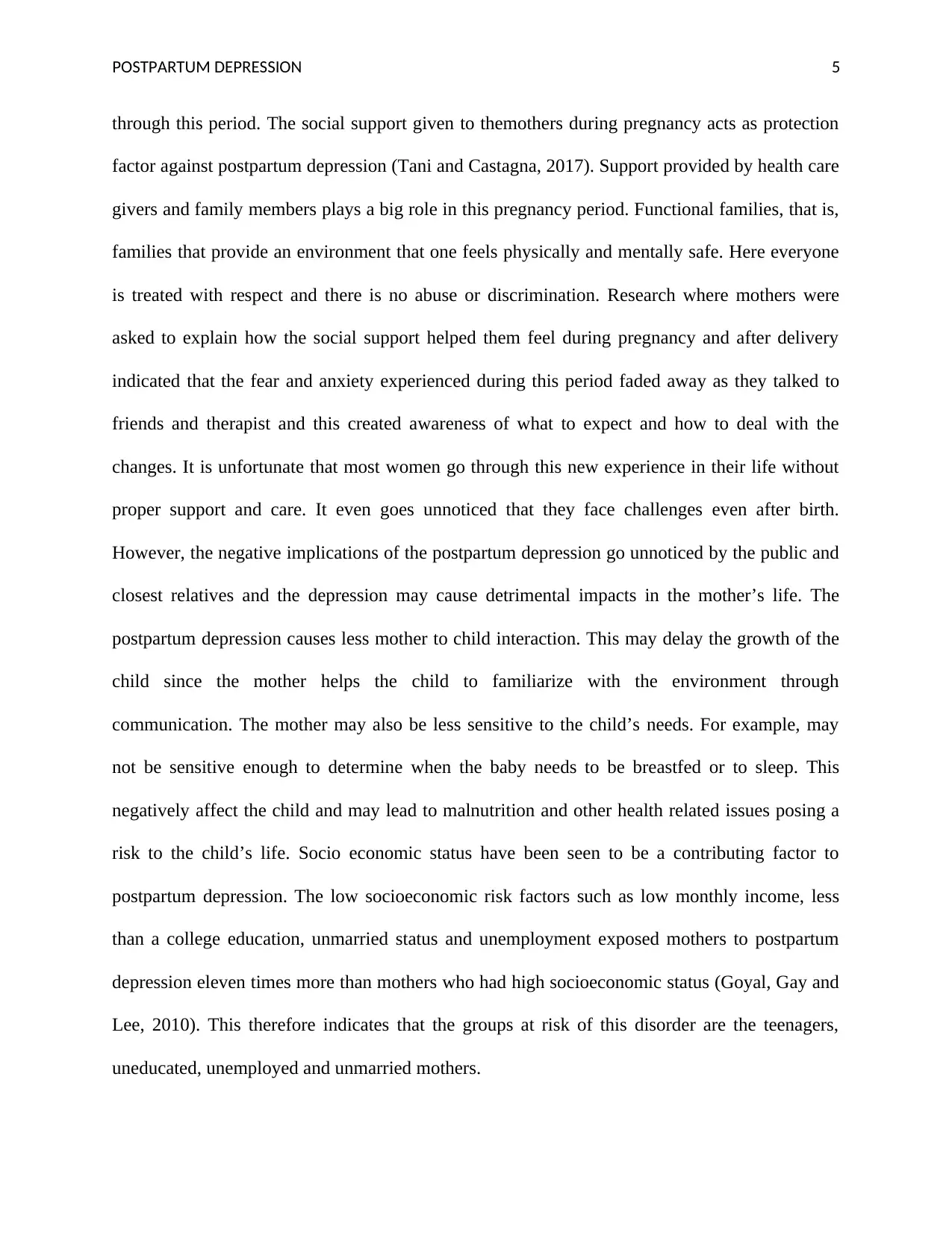
POSTPARTUM DEPRESSION 5
through this period. The social support given to themothers during pregnancy acts as protection
factor against postpartum depression (Tani and Castagna, 2017). Support provided by health care
givers and family members plays a big role in this pregnancy period. Functional families, that is,
families that provide an environment that one feels physically and mentally safe. Here everyone
is treated with respect and there is no abuse or discrimination. Research where mothers were
asked to explain how the social support helped them feel during pregnancy and after delivery
indicated that the fear and anxiety experienced during this period faded away as they talked to
friends and therapist and this created awareness of what to expect and how to deal with the
changes. It is unfortunate that most women go through this new experience in their life without
proper support and care. It even goes unnoticed that they face challenges even after birth.
However, the negative implications of the postpartum depression go unnoticed by the public and
closest relatives and the depression may cause detrimental impacts in the mother’s life. The
postpartum depression causes less mother to child interaction. This may delay the growth of the
child since the mother helps the child to familiarize with the environment through
communication. The mother may also be less sensitive to the child’s needs. For example, may
not be sensitive enough to determine when the baby needs to be breastfed or to sleep. This
negatively affect the child and may lead to malnutrition and other health related issues posing a
risk to the child’s life. Socio economic status have been seen to be a contributing factor to
postpartum depression. The low socioeconomic risk factors such as low monthly income, less
than a college education, unmarried status and unemployment exposed mothers to postpartum
depression eleven times more than mothers who had high socioeconomic status (Goyal, Gay and
Lee, 2010). This therefore indicates that the groups at risk of this disorder are the teenagers,
uneducated, unemployed and unmarried mothers.
through this period. The social support given to themothers during pregnancy acts as protection
factor against postpartum depression (Tani and Castagna, 2017). Support provided by health care
givers and family members plays a big role in this pregnancy period. Functional families, that is,
families that provide an environment that one feels physically and mentally safe. Here everyone
is treated with respect and there is no abuse or discrimination. Research where mothers were
asked to explain how the social support helped them feel during pregnancy and after delivery
indicated that the fear and anxiety experienced during this period faded away as they talked to
friends and therapist and this created awareness of what to expect and how to deal with the
changes. It is unfortunate that most women go through this new experience in their life without
proper support and care. It even goes unnoticed that they face challenges even after birth.
However, the negative implications of the postpartum depression go unnoticed by the public and
closest relatives and the depression may cause detrimental impacts in the mother’s life. The
postpartum depression causes less mother to child interaction. This may delay the growth of the
child since the mother helps the child to familiarize with the environment through
communication. The mother may also be less sensitive to the child’s needs. For example, may
not be sensitive enough to determine when the baby needs to be breastfed or to sleep. This
negatively affect the child and may lead to malnutrition and other health related issues posing a
risk to the child’s life. Socio economic status have been seen to be a contributing factor to
postpartum depression. The low socioeconomic risk factors such as low monthly income, less
than a college education, unmarried status and unemployment exposed mothers to postpartum
depression eleven times more than mothers who had high socioeconomic status (Goyal, Gay and
Lee, 2010). This therefore indicates that the groups at risk of this disorder are the teenagers,
uneducated, unemployed and unmarried mothers.
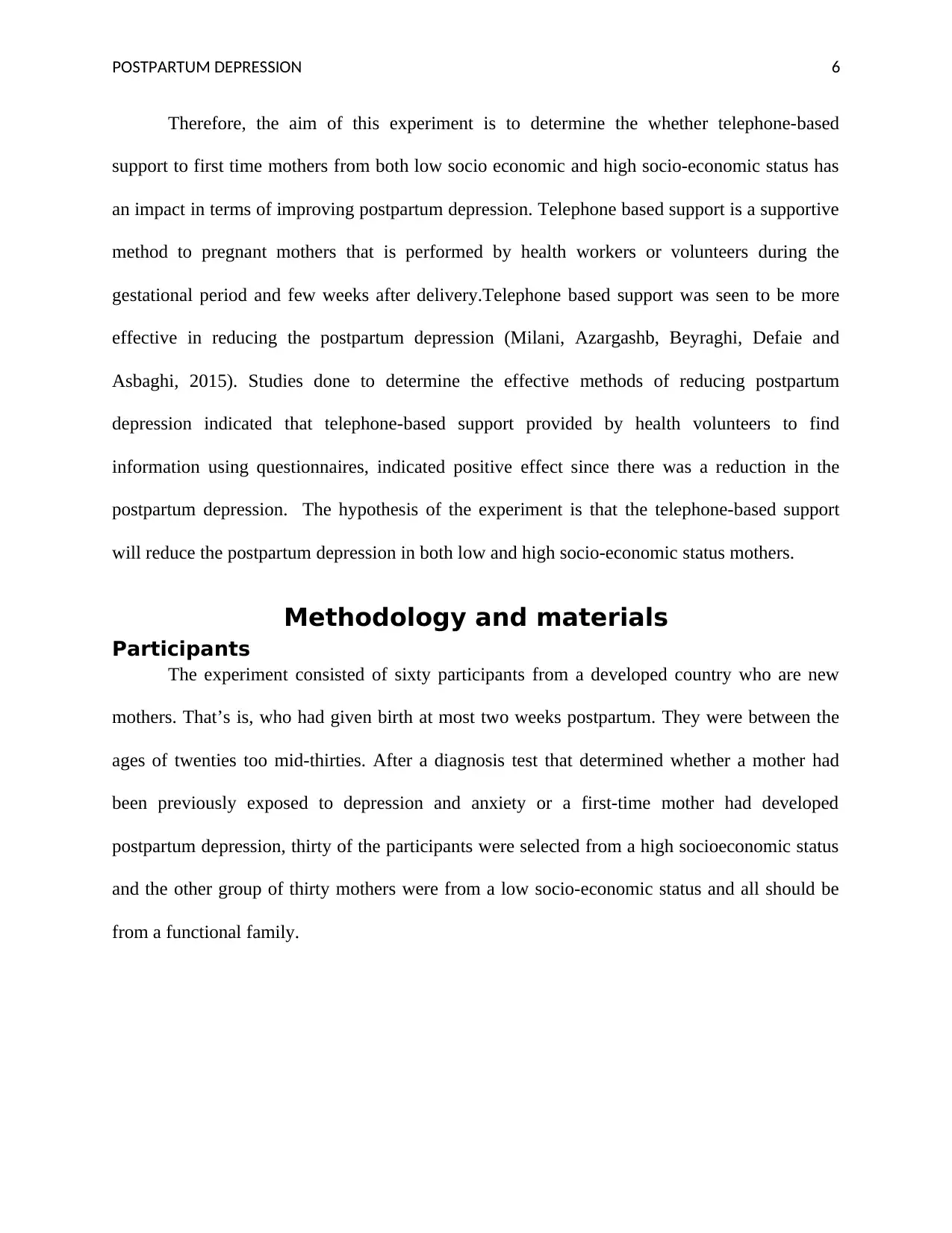
POSTPARTUM DEPRESSION 6
Therefore, the aim of this experiment is to determine the whether telephone-based
support to first time mothers from both low socio economic and high socio-economic status has
an impact in terms of improving postpartum depression. Telephone based support is a supportive
method to pregnant mothers that is performed by health workers or volunteers during the
gestational period and few weeks after delivery.Telephone based support was seen to be more
effective in reducing the postpartum depression (Milani, Azargashb, Beyraghi, Defaie and
Asbaghi, 2015). Studies done to determine the effective methods of reducing postpartum
depression indicated that telephone-based support provided by health volunteers to find
information using questionnaires, indicated positive effect since there was a reduction in the
postpartum depression. The hypothesis of the experiment is that the telephone-based support
will reduce the postpartum depression in both low and high socio-economic status mothers.
Methodology and materials
Participants
The experiment consisted of sixty participants from a developed country who are new
mothers. That’s is, who had given birth at most two weeks postpartum. They were between the
ages of twenties too mid-thirties. After a diagnosis test that determined whether a mother had
been previously exposed to depression and anxiety or a first-time mother had developed
postpartum depression, thirty of the participants were selected from a high socioeconomic status
and the other group of thirty mothers were from a low socio-economic status and all should be
from a functional family.
Therefore, the aim of this experiment is to determine the whether telephone-based
support to first time mothers from both low socio economic and high socio-economic status has
an impact in terms of improving postpartum depression. Telephone based support is a supportive
method to pregnant mothers that is performed by health workers or volunteers during the
gestational period and few weeks after delivery.Telephone based support was seen to be more
effective in reducing the postpartum depression (Milani, Azargashb, Beyraghi, Defaie and
Asbaghi, 2015). Studies done to determine the effective methods of reducing postpartum
depression indicated that telephone-based support provided by health volunteers to find
information using questionnaires, indicated positive effect since there was a reduction in the
postpartum depression. The hypothesis of the experiment is that the telephone-based support
will reduce the postpartum depression in both low and high socio-economic status mothers.
Methodology and materials
Participants
The experiment consisted of sixty participants from a developed country who are new
mothers. That’s is, who had given birth at most two weeks postpartum. They were between the
ages of twenties too mid-thirties. After a diagnosis test that determined whether a mother had
been previously exposed to depression and anxiety or a first-time mother had developed
postpartum depression, thirty of the participants were selected from a high socioeconomic status
and the other group of thirty mothers were from a low socio-economic status and all should be
from a functional family.
⊘ This is a preview!⊘
Do you want full access?
Subscribe today to unlock all pages.

Trusted by 1+ million students worldwide
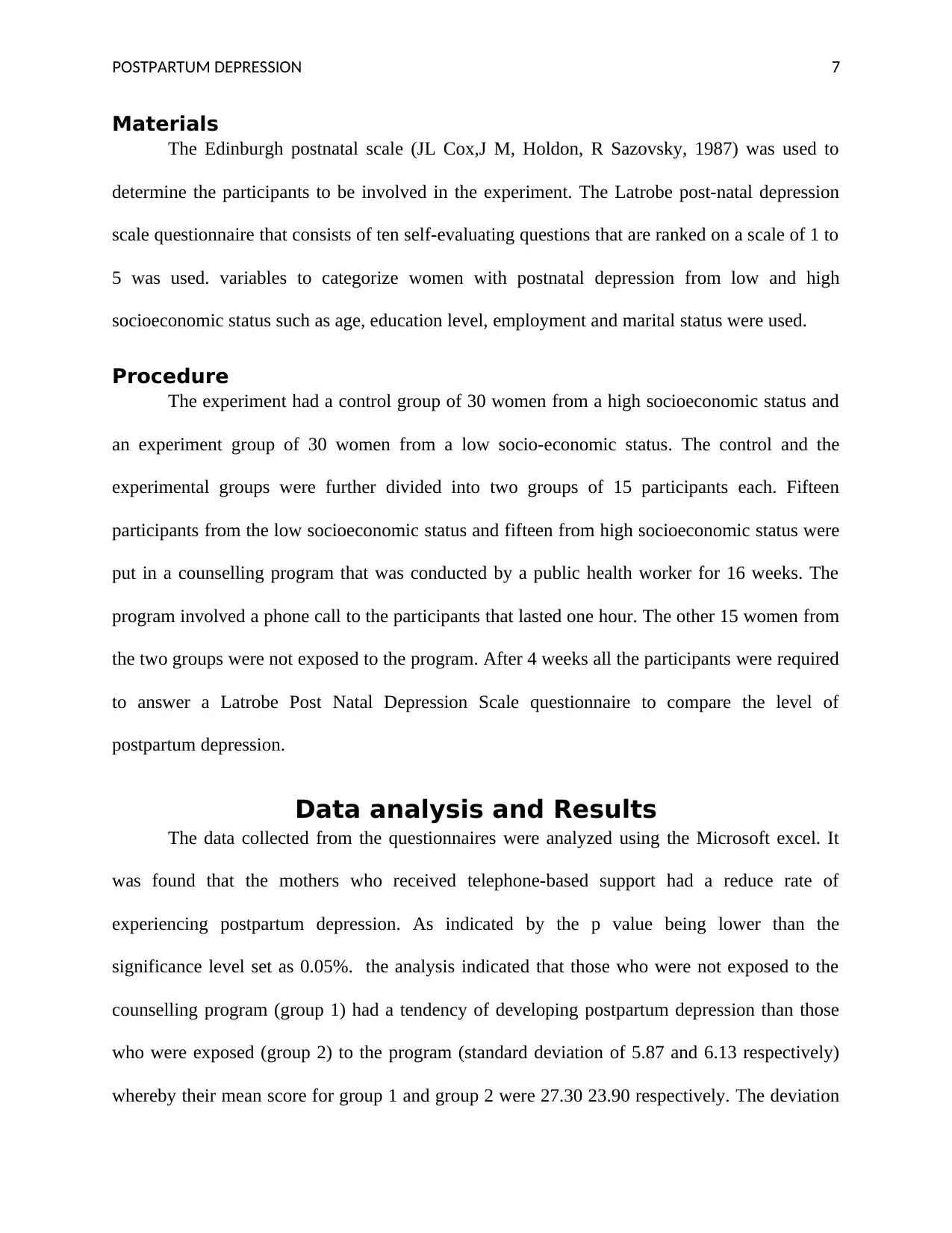
POSTPARTUM DEPRESSION 7
Materials
The Edinburgh postnatal scale (JL Cox,J M, Holdon, R Sazovsky, 1987) was used to
determine the participants to be involved in the experiment. The Latrobe post-natal depression
scale questionnaire that consists of ten self-evaluating questions that are ranked on a scale of 1 to
5 was used. variables to categorize women with postnatal depression from low and high
socioeconomic status such as age, education level, employment and marital status were used.
Procedure
The experiment had a control group of 30 women from a high socioeconomic status and
an experiment group of 30 women from a low socio-economic status. The control and the
experimental groups were further divided into two groups of 15 participants each. Fifteen
participants from the low socioeconomic status and fifteen from high socioeconomic status were
put in a counselling program that was conducted by a public health worker for 16 weeks. The
program involved a phone call to the participants that lasted one hour. The other 15 women from
the two groups were not exposed to the program. After 4 weeks all the participants were required
to answer a Latrobe Post Natal Depression Scale questionnaire to compare the level of
postpartum depression.
Data analysis and Results
The data collected from the questionnaires were analyzed using the Microsoft excel. It
was found that the mothers who received telephone-based support had a reduce rate of
experiencing postpartum depression. As indicated by the p value being lower than the
significance level set as 0.05%. the analysis indicated that those who were not exposed to the
counselling program (group 1) had a tendency of developing postpartum depression than those
who were exposed (group 2) to the program (standard deviation of 5.87 and 6.13 respectively)
whereby their mean score for group 1 and group 2 were 27.30 23.90 respectively. The deviation
Materials
The Edinburgh postnatal scale (JL Cox,J M, Holdon, R Sazovsky, 1987) was used to
determine the participants to be involved in the experiment. The Latrobe post-natal depression
scale questionnaire that consists of ten self-evaluating questions that are ranked on a scale of 1 to
5 was used. variables to categorize women with postnatal depression from low and high
socioeconomic status such as age, education level, employment and marital status were used.
Procedure
The experiment had a control group of 30 women from a high socioeconomic status and
an experiment group of 30 women from a low socio-economic status. The control and the
experimental groups were further divided into two groups of 15 participants each. Fifteen
participants from the low socioeconomic status and fifteen from high socioeconomic status were
put in a counselling program that was conducted by a public health worker for 16 weeks. The
program involved a phone call to the participants that lasted one hour. The other 15 women from
the two groups were not exposed to the program. After 4 weeks all the participants were required
to answer a Latrobe Post Natal Depression Scale questionnaire to compare the level of
postpartum depression.
Data analysis and Results
The data collected from the questionnaires were analyzed using the Microsoft excel. It
was found that the mothers who received telephone-based support had a reduce rate of
experiencing postpartum depression. As indicated by the p value being lower than the
significance level set as 0.05%. the analysis indicated that those who were not exposed to the
counselling program (group 1) had a tendency of developing postpartum depression than those
who were exposed (group 2) to the program (standard deviation of 5.87 and 6.13 respectively)
whereby their mean score for group 1 and group 2 were 27.30 23.90 respectively. The deviation
Paraphrase This Document
Need a fresh take? Get an instant paraphrase of this document with our AI Paraphraser
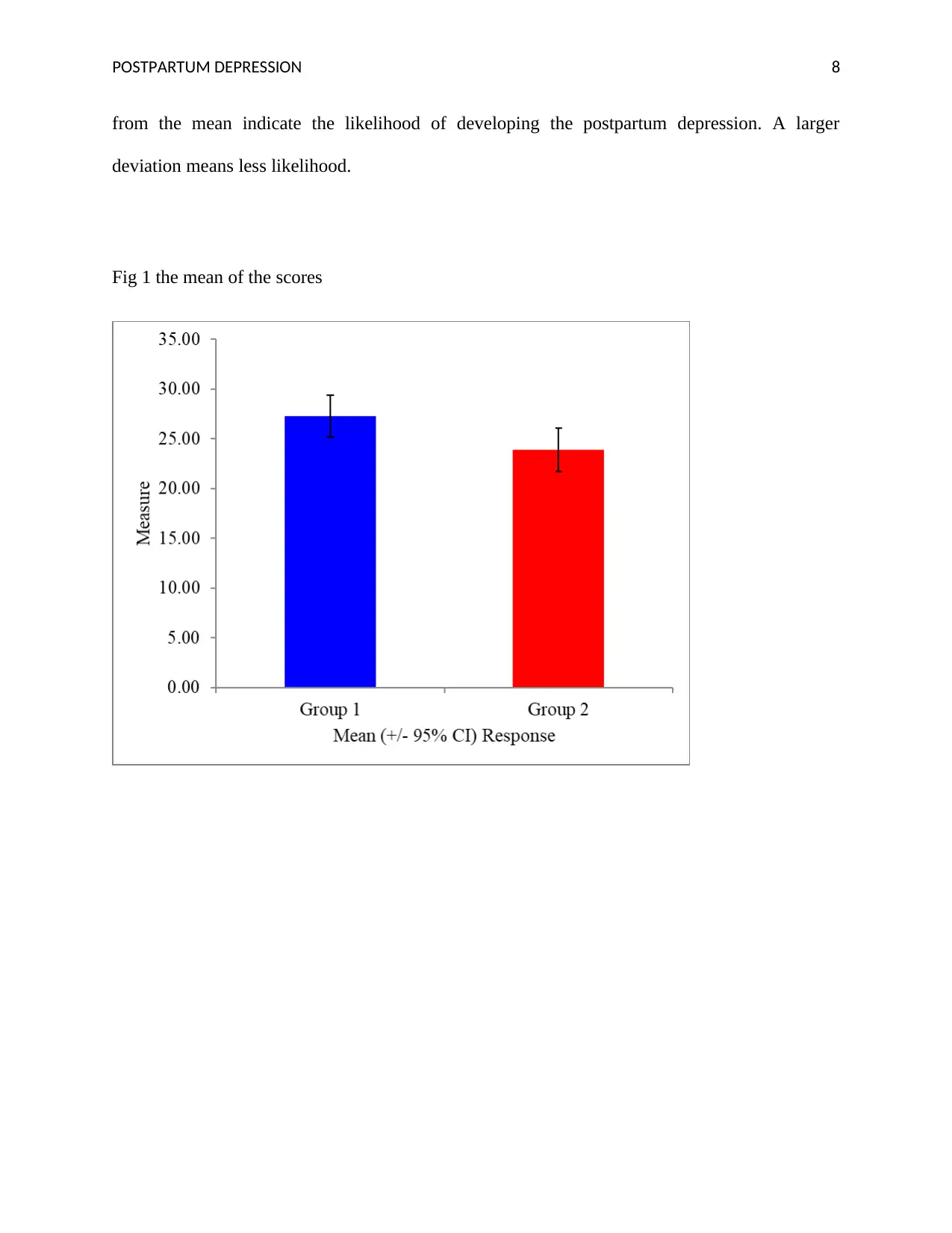
POSTPARTUM DEPRESSION 8
from the mean indicate the likelihood of developing the postpartum depression. A larger
deviation means less likelihood.
Fig 1 the mean of the scores
from the mean indicate the likelihood of developing the postpartum depression. A larger
deviation means less likelihood.
Fig 1 the mean of the scores
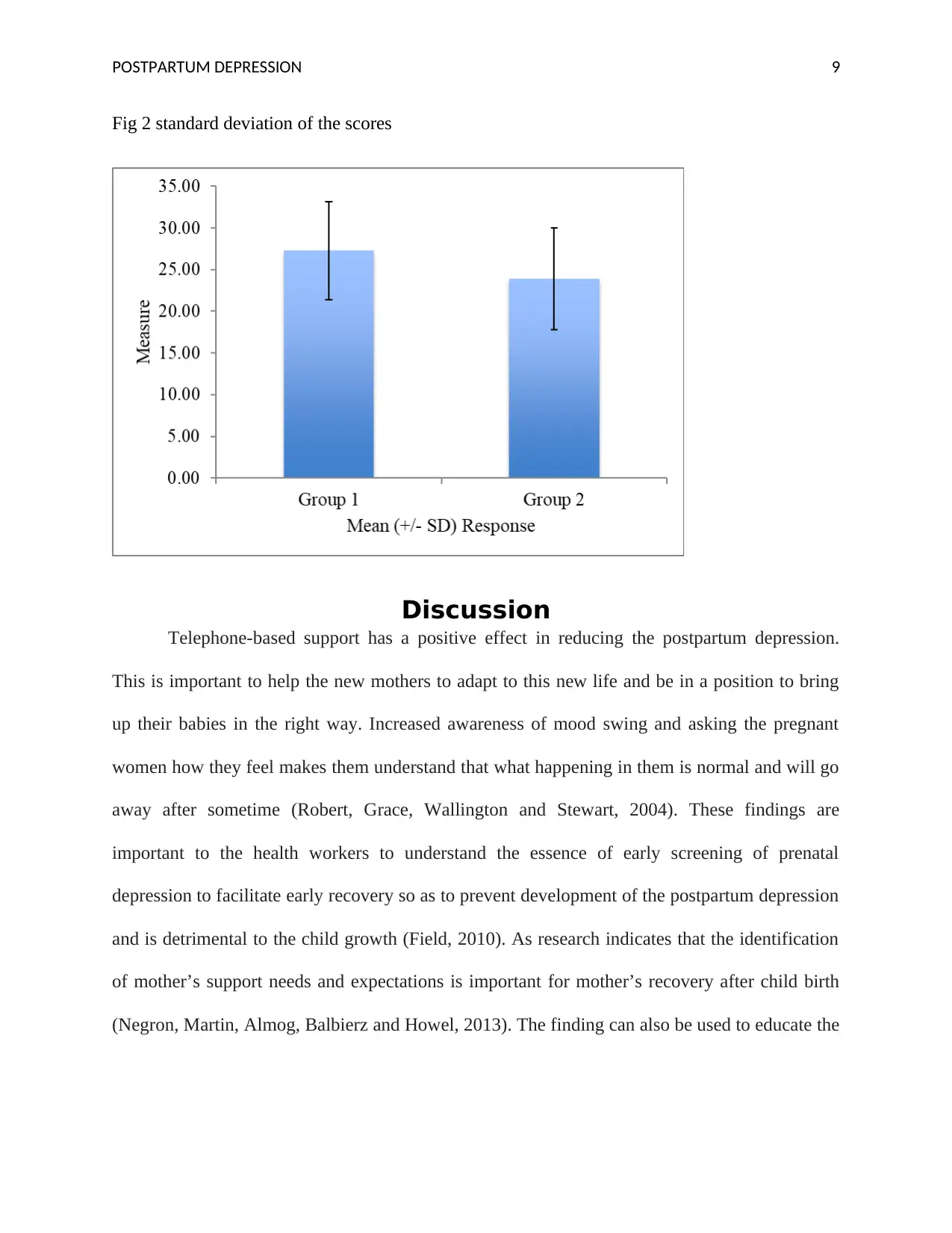
POSTPARTUM DEPRESSION 9
Fig 2 standard deviation of the scores
Discussion
Telephone-based support has a positive effect in reducing the postpartum depression.
This is important to help the new mothers to adapt to this new life and be in a position to bring
up their babies in the right way. Increased awareness of mood swing and asking the pregnant
women how they feel makes them understand that what happening in them is normal and will go
away after sometime (Robert, Grace, Wallington and Stewart, 2004). These findings are
important to the health workers to understand the essence of early screening of prenatal
depression to facilitate early recovery so as to prevent development of the postpartum depression
and is detrimental to the child growth (Field, 2010). As research indicates that the identification
of mother’s support needs and expectations is important for mother’s recovery after child birth
(Negron, Martin, Almog, Balbierz and Howel, 2013). The finding can also be used to educate the
Fig 2 standard deviation of the scores
Discussion
Telephone-based support has a positive effect in reducing the postpartum depression.
This is important to help the new mothers to adapt to this new life and be in a position to bring
up their babies in the right way. Increased awareness of mood swing and asking the pregnant
women how they feel makes them understand that what happening in them is normal and will go
away after sometime (Robert, Grace, Wallington and Stewart, 2004). These findings are
important to the health workers to understand the essence of early screening of prenatal
depression to facilitate early recovery so as to prevent development of the postpartum depression
and is detrimental to the child growth (Field, 2010). As research indicates that the identification
of mother’s support needs and expectations is important for mother’s recovery after child birth
(Negron, Martin, Almog, Balbierz and Howel, 2013). The finding can also be used to educate the
⊘ This is a preview!⊘
Do you want full access?
Subscribe today to unlock all pages.

Trusted by 1+ million students worldwide
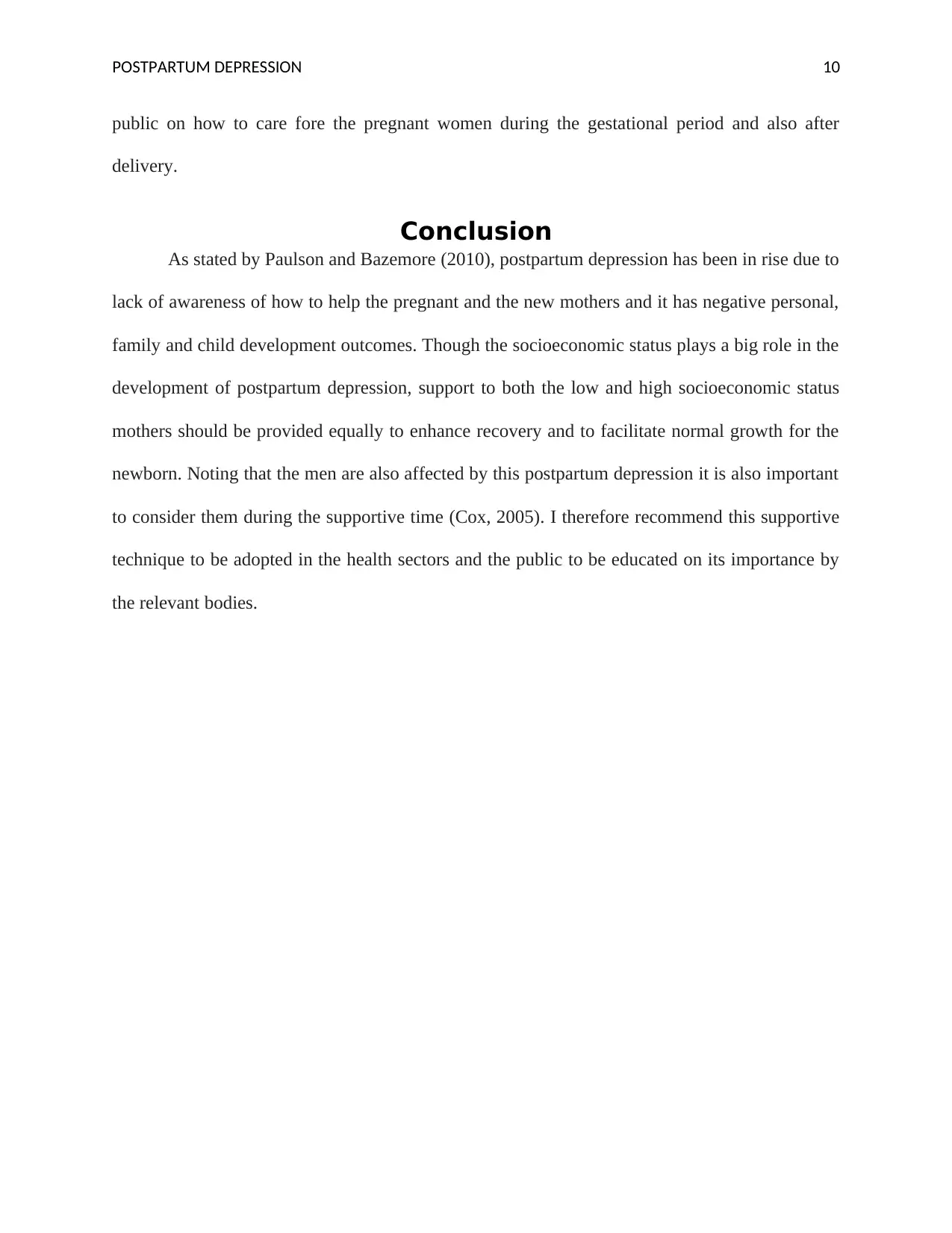
POSTPARTUM DEPRESSION 10
public on how to care fore the pregnant women during the gestational period and also after
delivery.
Conclusion
As stated by Paulson and Bazemore (2010), postpartum depression has been in rise due to
lack of awareness of how to help the pregnant and the new mothers and it has negative personal,
family and child development outcomes. Though the socioeconomic status plays a big role in the
development of postpartum depression, support to both the low and high socioeconomic status
mothers should be provided equally to enhance recovery and to facilitate normal growth for the
newborn. Noting that the men are also affected by this postpartum depression it is also important
to consider them during the supportive time (Cox, 2005). I therefore recommend this supportive
technique to be adopted in the health sectors and the public to be educated on its importance by
the relevant bodies.
public on how to care fore the pregnant women during the gestational period and also after
delivery.
Conclusion
As stated by Paulson and Bazemore (2010), postpartum depression has been in rise due to
lack of awareness of how to help the pregnant and the new mothers and it has negative personal,
family and child development outcomes. Though the socioeconomic status plays a big role in the
development of postpartum depression, support to both the low and high socioeconomic status
mothers should be provided equally to enhance recovery and to facilitate normal growth for the
newborn. Noting that the men are also affected by this postpartum depression it is also important
to consider them during the supportive time (Cox, 2005). I therefore recommend this supportive
technique to be adopted in the health sectors and the public to be educated on its importance by
the relevant bodies.
Paraphrase This Document
Need a fresh take? Get an instant paraphrase of this document with our AI Paraphraser
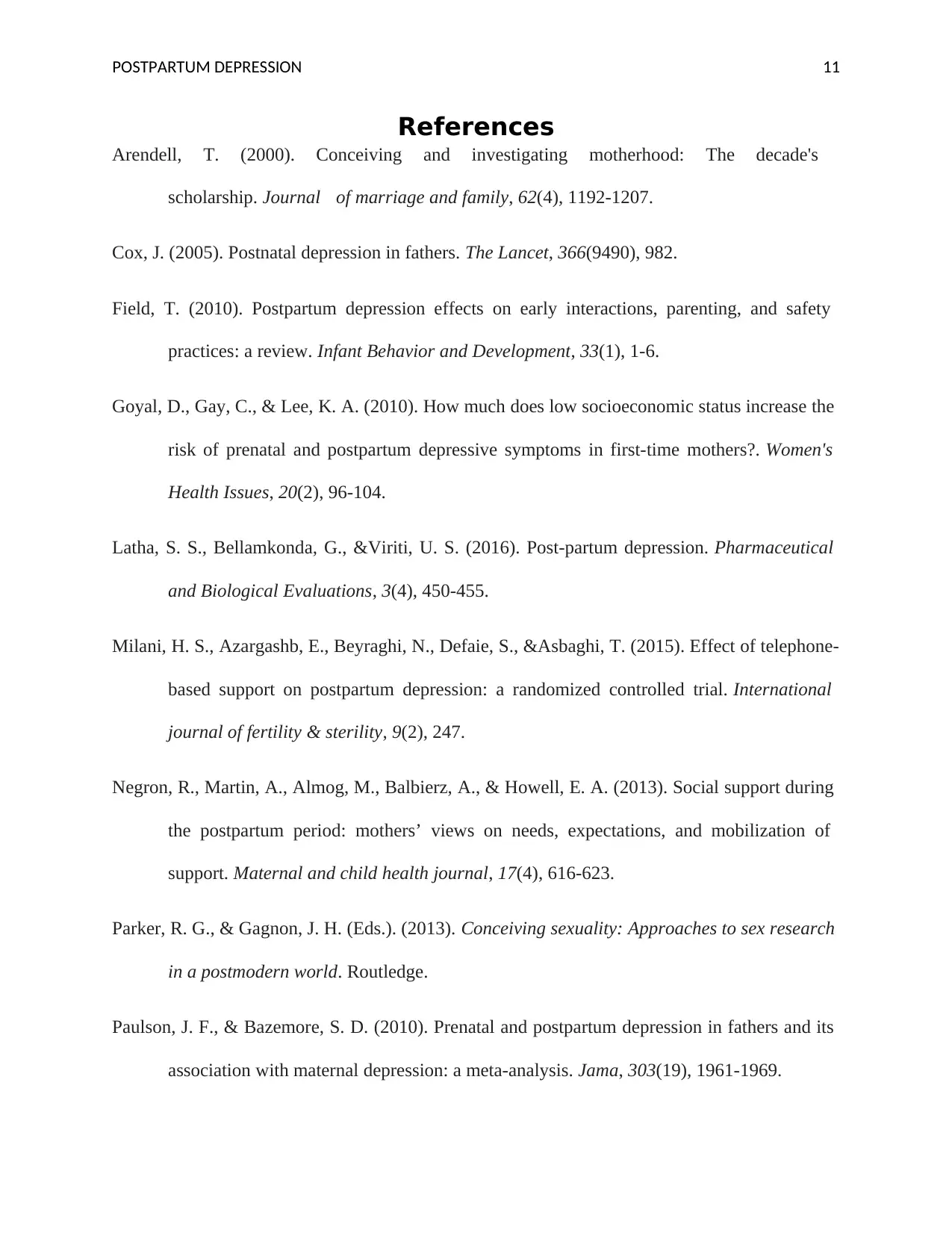
POSTPARTUM DEPRESSION 11
References
Arendell, T. (2000). Conceiving and investigating motherhood: The decade's
scholarship. Journal of marriage and family, 62(4), 1192-1207.
Cox, J. (2005). Postnatal depression in fathers. The Lancet, 366(9490), 982.
Field, T. (2010). Postpartum depression effects on early interactions, parenting, and safety
practices: a review. Infant Behavior and Development, 33(1), 1-6.
Goyal, D., Gay, C., & Lee, K. A. (2010). How much does low socioeconomic status increase the
risk of prenatal and postpartum depressive symptoms in first-time mothers?. Women's
Health Issues, 20(2), 96-104.
Latha, S. S., Bellamkonda, G., &Viriti, U. S. (2016). Post-partum depression. Pharmaceutical
and Biological Evaluations, 3(4), 450-455.
Milani, H. S., Azargashb, E., Beyraghi, N., Defaie, S., &Asbaghi, T. (2015). Effect of telephone-
based support on postpartum depression: a randomized controlled trial. International
journal of fertility & sterility, 9(2), 247.
Negron, R., Martin, A., Almog, M., Balbierz, A., & Howell, E. A. (2013). Social support during
the postpartum period: mothers’ views on needs, expectations, and mobilization of
support. Maternal and child health journal, 17(4), 616-623.
Parker, R. G., & Gagnon, J. H. (Eds.). (2013). Conceiving sexuality: Approaches to sex research
in a postmodern world. Routledge.
Paulson, J. F., & Bazemore, S. D. (2010). Prenatal and postpartum depression in fathers and its
association with maternal depression: a meta-analysis. Jama, 303(19), 1961-1969.
References
Arendell, T. (2000). Conceiving and investigating motherhood: The decade's
scholarship. Journal of marriage and family, 62(4), 1192-1207.
Cox, J. (2005). Postnatal depression in fathers. The Lancet, 366(9490), 982.
Field, T. (2010). Postpartum depression effects on early interactions, parenting, and safety
practices: a review. Infant Behavior and Development, 33(1), 1-6.
Goyal, D., Gay, C., & Lee, K. A. (2010). How much does low socioeconomic status increase the
risk of prenatal and postpartum depressive symptoms in first-time mothers?. Women's
Health Issues, 20(2), 96-104.
Latha, S. S., Bellamkonda, G., &Viriti, U. S. (2016). Post-partum depression. Pharmaceutical
and Biological Evaluations, 3(4), 450-455.
Milani, H. S., Azargashb, E., Beyraghi, N., Defaie, S., &Asbaghi, T. (2015). Effect of telephone-
based support on postpartum depression: a randomized controlled trial. International
journal of fertility & sterility, 9(2), 247.
Negron, R., Martin, A., Almog, M., Balbierz, A., & Howell, E. A. (2013). Social support during
the postpartum period: mothers’ views on needs, expectations, and mobilization of
support. Maternal and child health journal, 17(4), 616-623.
Parker, R. G., & Gagnon, J. H. (Eds.). (2013). Conceiving sexuality: Approaches to sex research
in a postmodern world. Routledge.
Paulson, J. F., & Bazemore, S. D. (2010). Prenatal and postpartum depression in fathers and its
association with maternal depression: a meta-analysis. Jama, 303(19), 1961-1969.
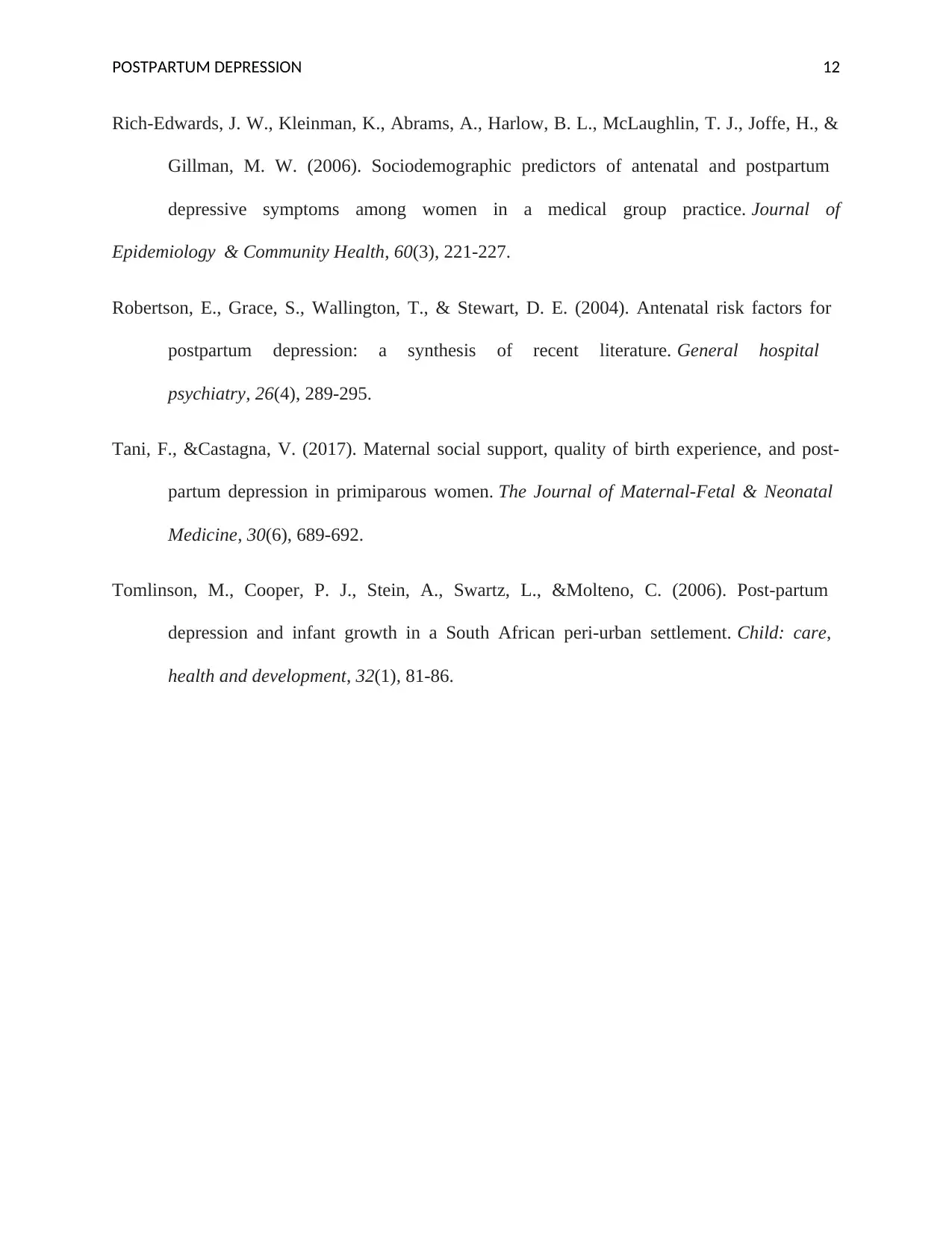
POSTPARTUM DEPRESSION 12
Rich-Edwards, J. W., Kleinman, K., Abrams, A., Harlow, B. L., McLaughlin, T. J., Joffe, H., &
Gillman, M. W. (2006). Sociodemographic predictors of antenatal and postpartum
depressive symptoms among women in a medical group practice. Journal of
Epidemiology & Community Health, 60(3), 221-227.
Robertson, E., Grace, S., Wallington, T., & Stewart, D. E. (2004). Antenatal risk factors for
postpartum depression: a synthesis of recent literature. General hospital
psychiatry, 26(4), 289-295.
Tani, F., &Castagna, V. (2017). Maternal social support, quality of birth experience, and post-
partum depression in primiparous women. The Journal of Maternal-Fetal & Neonatal
Medicine, 30(6), 689-692.
Tomlinson, M., Cooper, P. J., Stein, A., Swartz, L., &Molteno, C. (2006). Post‐partum
depression and infant growth in a South African peri‐urban settlement. Child: care,
health and development, 32(1), 81-86.
Rich-Edwards, J. W., Kleinman, K., Abrams, A., Harlow, B. L., McLaughlin, T. J., Joffe, H., &
Gillman, M. W. (2006). Sociodemographic predictors of antenatal and postpartum
depressive symptoms among women in a medical group practice. Journal of
Epidemiology & Community Health, 60(3), 221-227.
Robertson, E., Grace, S., Wallington, T., & Stewart, D. E. (2004). Antenatal risk factors for
postpartum depression: a synthesis of recent literature. General hospital
psychiatry, 26(4), 289-295.
Tani, F., &Castagna, V. (2017). Maternal social support, quality of birth experience, and post-
partum depression in primiparous women. The Journal of Maternal-Fetal & Neonatal
Medicine, 30(6), 689-692.
Tomlinson, M., Cooper, P. J., Stein, A., Swartz, L., &Molteno, C. (2006). Post‐partum
depression and infant growth in a South African peri‐urban settlement. Child: care,
health and development, 32(1), 81-86.
⊘ This is a preview!⊘
Do you want full access?
Subscribe today to unlock all pages.

Trusted by 1+ million students worldwide
1 out of 12
Related Documents
Your All-in-One AI-Powered Toolkit for Academic Success.
+13062052269
info@desklib.com
Available 24*7 on WhatsApp / Email
![[object Object]](/_next/static/media/star-bottom.7253800d.svg)
Unlock your academic potential
Copyright © 2020–2025 A2Z Services. All Rights Reserved. Developed and managed by ZUCOL.





